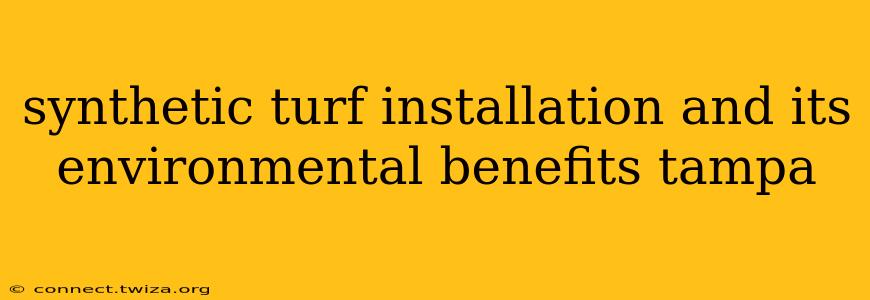Tampa's sunny climate and active lifestyle make synthetic turf a popular choice for homeowners and businesses alike. But beyond its aesthetic appeal and low maintenance, synthetic turf offers significant environmental benefits. This article delves into the advantages of synthetic turf installation in Tampa and addresses common questions surrounding its environmental impact.
Is Synthetic Turf Better for the Environment Than Natural Grass?
This is a complex question with no simple yes or no answer. The environmental impact of both natural and synthetic turf depends on several factors, including water usage, fertilizer application, and the manufacturing and disposal processes. However, in many cases, especially in drier climates like Tampa's, synthetic turf demonstrates a more environmentally friendly profile.
Natural grass requires significant amounts of water for irrigation, especially during the hot and dry Tampa summers. This water consumption contributes to depleting water resources and increased energy use for pumping and treating water. Fertilizers and pesticides used to maintain a healthy lawn can run off into waterways, causing pollution and harming aquatic life. The mowing process also contributes to greenhouse gas emissions through the use of gasoline-powered equipment.
Synthetic turf, on the other hand, eliminates the need for watering, fertilizing, and pesticide use, resulting in significant reductions in water consumption and pollution. While the manufacturing process does have an environmental footprint, the reduced resource consumption over the lifespan of the turf often makes it a more sustainable choice, particularly in areas with water scarcity.
What are the Environmental Benefits of Synthetic Turf in Tampa?
The environmental advantages of synthetic turf in Tampa are substantial:
-
Water Conservation: This is perhaps the most significant benefit. Synthetic turf requires zero watering, conserving a precious resource, especially crucial in a region prone to drought.
-
Reduced Pesticide and Fertilizer Use: Eliminating the need for chemical treatments protects local waterways and ecosystems from harmful runoff. This also reduces the risk of exposure to these chemicals for children and pets.
-
Lower Greenhouse Gas Emissions: Less mowing means less reliance on gasoline-powered equipment, contributing to a reduction in carbon emissions.
-
Reduced Landfill Waste: Synthetic turf has a longer lifespan than natural grass, reducing the frequency of replacement and the amount of organic waste sent to landfills.
-
Improved Air Quality: Reduced pesticide use contributes to better air quality, particularly beneficial for those with respiratory sensitivities.
What are the Disadvantages of Synthetic Turf?
It's important to acknowledge that synthetic turf isn't without its drawbacks:
-
Manufacturing Process: The production of synthetic turf does require energy and resources, and some concerns exist regarding the use of certain materials. However, advancements in manufacturing are leading to more environmentally friendly options.
-
End-of-Life Disposal: Proper disposal of synthetic turf at the end of its lifespan is crucial. Many manufacturers are developing programs for recycling and repurposing old turf. Responsible disposal methods are essential to mitigate any negative environmental impact.
-
Potential for Heat Island Effect: Synthetic turf can retain heat, potentially contributing to the urban heat island effect. However, advancements in infill materials are addressing this concern, with some options designed to reflect heat and reduce surface temperatures.
How Long Does Synthetic Turf Last?
The lifespan of synthetic turf varies depending on the quality of the turf, installation, and level of use. High-quality synthetic turf can last for 10-15 years or even longer with proper maintenance. This longevity reduces the frequency of replacement, minimizing the overall environmental impact compared to frequently replacing natural grass.
Is Synthetic Turf Safe for Children and Pets?
Modern synthetic turf is designed with safety in mind. Many products are made with non-toxic materials and are tested to meet rigorous safety standards. However, it's essential to choose reputable brands and installers who prioritize the use of safe materials and proper installation techniques.
Where Can I Find a Reputable Synthetic Turf Installer in Tampa?
Choosing a reputable installer is crucial for ensuring a successful and environmentally responsible installation. Research local installers, read reviews, and verify their experience and commitment to sustainable practices.
In conclusion, while both natural and synthetic turf have environmental considerations, synthetic turf offers compelling advantages in Tampa's climate, particularly in terms of water conservation and reduced pollution. By choosing high-quality products, responsible installers, and proper end-of-life disposal methods, the environmental benefits of synthetic turf can be maximized. Choosing synthetic turf is a decision that balances aesthetics, practicality, and environmental responsibility.
